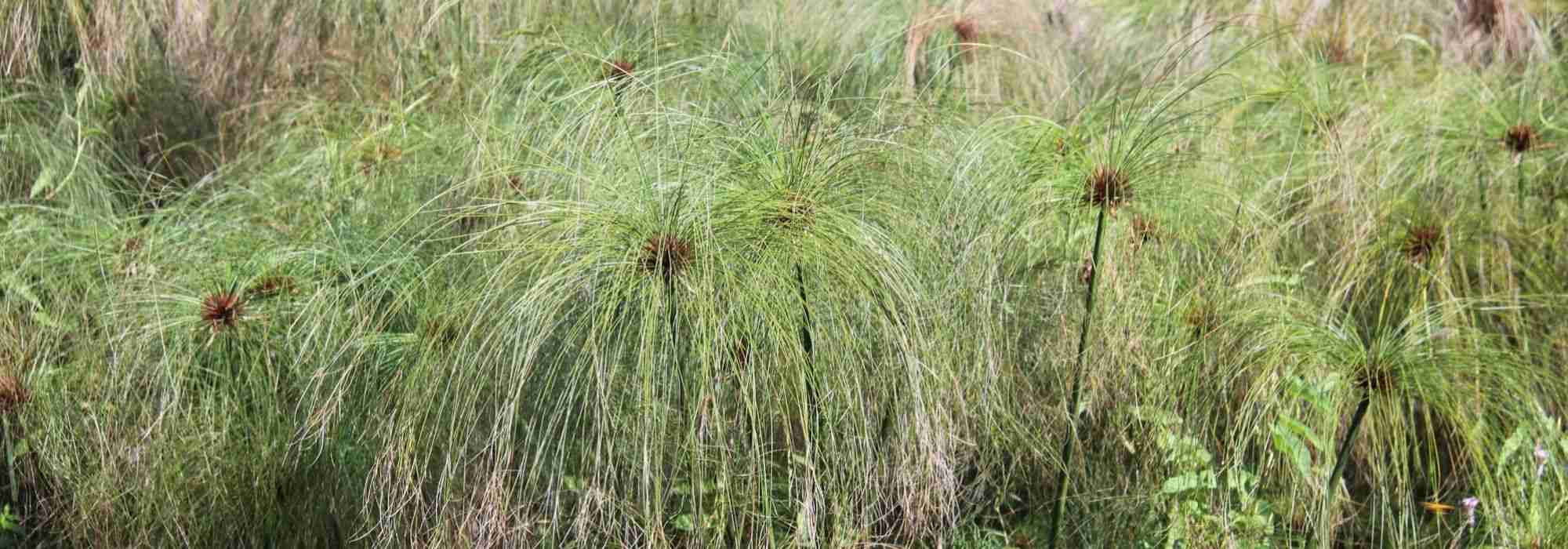
Papyrus, Cyperus: planting and care
Contents
Cyperus, in a nutshell
- Papyrus or sedges are entirely green plants of wet mediums with a graphic style that form stiff clumps topped with radiating heads.
- Easy to grow in an outdoor pond or in a pot, some species such as Papyrus of the Nile and Cyperus alternifolius must, however, be brought indoors for winter in most regions of France.
- Other species such as Cyperus glaber, Cyperus longus are plants with an exotic style, admittedly less spectacular but quite hardy, suitable for all situations, on a balcony, in the house or at the edge of a pond.
Word from our expert
Papyrus, also called paper sedges, evoke for most people the earliest paper supports invented by the Egyptians, which have endured to the present day. Pith, cut into fine woven strips, forms basis of this very durable paper. Plant bearing the scientific name Cyperus papyrus appears repeatedly in stylised Egyptian paintings, like the lotus, symbolising respectively Lower and Upper Egypt and, beyond that, the Nile, source of life for a civilisation living at edge of the desert. Nile delta now hosts very few papyrus, but it is increasingly used in aquatic gardens, in well-watered borders and even in seasonal flower displays that decorate our towns in summer.
Spectacular effect of Nile papyrus arguably makes it most majestic of aquatic plants in mild climate, as it suffers at first frosts and disappears if thermometer falls below -3°C. It can also be kept fairly easily indoors in a pot standing on a deep saucer constantly filled with water, or as a houseplant in a bathroom, or even grown as an annual. Simply give this papyrus, hungry for light and warmth, a very sunny position and a secure shelter for winter.
Indoors, graphic effect is guaranteed even in winter if you have a conservatory or a spot behind a south- or south-west-facing bay window. Plant can also overwinter in a frost-free greenhouse. Its feathery umbels remain open, perched at 2 m height or much lower in cultivars selected for floral arrangements. Papyrus plants are entirely green from base to inflorescences, although tiny flowers gleam a soft yellow amid thread-like bracts. When an inflorescence dries, its stem dies and new shoots arising from the stump replace it while the clump expands.
Medium-sized species such as Cyperus glaber, Cyperus longus are hardy and can grace pond margins mixed with native marginal plants such as Bulrush or Purple loosestrife, or with exotic plants such as Pontederia, Gunnera and Thalia dealbata.

Cyperus papyrus
Description and botany
Botanical data
- Latin name Cyperus
- Family Cyperaceae
- Common name Papyrus, nut-sedge
- Flowering between May and October
- Height between 0.50 and 3 m
- Exposure full sun to partial shade
- Soil type any rich, moist to waterlogged soil, even calcareous
- Hardiness Good (-15 °C) to low (-3 °C)
Genus Cyperus comprises more than 600 species distributed in almost all wet habitats worldwide except the coldest. They can be annual or evergreen perennials, some being highly feared adventive in agriculture and horticulture such as Cyperus rotundus, native to India and extremely invasive. The most spectacular species by height and size of its inflorescences remains Cyperus papyrus, symbol of rebirth in ancient Egypt and of Lower Egypt, corresponding to the marshy area of the Nile delta. New, more compact cultivars such as ‘Cleopatra’ and ‘Akhenaton’ have the advantage of breaking less in the wind and suit container culture better.
Cyperus gave its name to the family to which it belongs: Cyperaceae. They form large clumps of thick, cylindrical or triangular stems — up to 3 cm wide at the base in Cyperus papyrus — reaching heights varying from 1.50 to 5 m in the Egyptian papyrus (Cyperus papyrus). The stems bear narrow gramineous leaves arising from the base as in Cyperus albostriatus or are entirely absent as in Nile papyrus. Some species are deciduous, disappearing in winter like Cyperus longus or glaber, while others such as C. alternifolius and C. papyrus persist if temperatures remain mild. In the latter, the plant bears no leaves but unfurls, at the top of the canes, huge tufts of very fine bracts forming a feathery-looking sphere. Cyperus possess rootstocks which allow fairly rapid extension of the plant and ease multiplication. All their aerial organs are chlorophyllous, compensating for absence of leaves where necessary.
Inflorescences, highly decorative for their graphic structure, form flat (in a whorl) or spherical umbels of bracts, up to 25 cm in diameter. These bracts are thread-like on Nile papyrus while forming blades 0.5 to 1 cm wide on Cyperus involucratus (syn. alternifolius) or albostriatus. Fine feathery spikes, yellowish or pale green, made up of rather insignificant hermaphrodite flowers, arise from the centre of the umbel and make the bracts’ glossy intense green shimmer.
At maturity, flowers turn brown during summer, releasing seeds dispersed by wind. Nile papyrus reproduces by seed dispersal and vegetatively, by lateral growth of its rootstocks in the mud, forming thick thickets along the banks that can reach 5 m in height and which only large animals such as hippopotamuses are likely to cross. Today, this emblematic species has almost disappeared from the Nile delta due to flood control and the many infrastructures lining the river (dams and riverbank developments). Species with flat umbels, for their part, produce roots from the “heads” as soon as these come into contact with water.
Cyperus are very easy plants to grow indoors and have the advantage of helping to purify indoor air in confined atmospheres. They also help humidify dry indoor air when a room is heated.
Main papyrus varieties
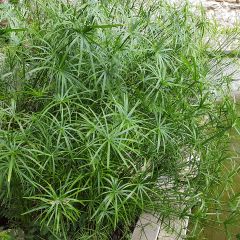
Cyperus alternifolius - Umbrella Papyrus
- Flowering time May, June
- Height at maturity 1 m
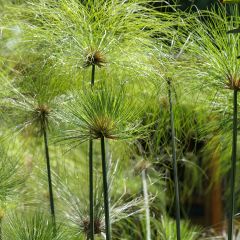
Cyperus papyrus - Papyrus
- Flowering time June, July
- Height at maturity 2 m
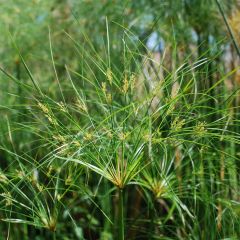
Cyperus papyrus Cleopatra - Papyrus
- Flowering time July, August
- Height at maturity 50 cm
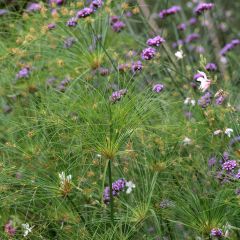
Cyperus papyrus Akhenaton
- Flowering time July to October
- Height at maturity 75 cm
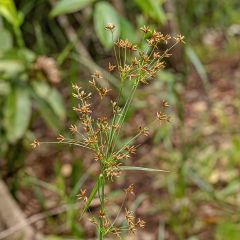
Cyperus longus
- Flowering time August to October
- Height at maturity 80 cm
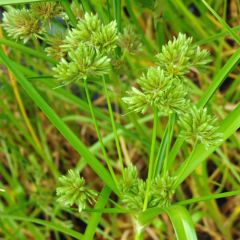
Cyperus glaber
- Flowering time August to October
- Height at maturity 60 cm
Discover other Cyperus
View all →Available in 2 sizes
Available in 1 sizes
Available in 2 sizes
Available in 1 sizes
Available in 1 sizes
Available in 1 sizes
Available in 1 sizes
Available in 1 sizes
Available in 2 sizes

Available in 1 sizes
Planting
Where to plant Papyrus?
Plant Cyperus preferably in full sun. Their growth will be reduced in partial shade. Prefer planting on the banks of a pond to ensure permanent moisture for the roots. All types of fairly rich soil suit them.
For Cyperus papyrus (Papyrus of the Nile) and alternifolius (umbrella plant), the submerged stump can survive if temperatures do not fall too low in winter (-6 to -8°C if soil is well drained for C. alternifolius), and the plant can regenerate the following spring. In regions away from the coast, it is essential to grow them in pots to bring indoors before the first frosts into a bright room. The umbrella plant tolerates the dry indoor atmosphere better than Papyrus of the Nile. Species glaber and longus tolerate down to -15°C without problem.
→ Learn more about growing Papyrus in pots
When to plant?
- Prefer spring to install papyrus outdoors.
- Wait until after the last frosts before putting the pot outside.
How to plant?
To plant in a pot, make a mix of potting compost and clayey or silty garden soil.
Choose a container large enough to allow the clump to expand, which happens quickly during the season.
Do not bury the rootball deeper than it was in its pot, but you can vary the water level above it by fully immersing the pot in water with 5 to 10 cm of water above it, or simply immersing the base of the container.
If you do not immerse the pot in a pond, place a deep saucer constantly filled with water under the pot.
- Be careful how you expose a plant coming out of a greenhouse or house. Acclimatise gradually to avoid burning foliage when moved out after winter.
- Consider dividing your papyrus when it becomes too large, and give divisions to friends and neighbours.
- Watch for the appearance of whiteflies or red spider mites indoors. These parasitic pests develop in dry, warm atmospheres.
- In open ground, work the soil well over at least 50 cm diameter.
- Enrich your soil if poor with potting compost or garden compost.
- Mulch generously with gravel or grass clippings to retain freshness.

Read also
Petasites: planting, cultivation, careCare
- Ensure soil remains consistently cool even if you do not let water stand in the saucer.
- From April to late September, apply to plants kept on a terrace or indoors, a liquid Green Plants fertiliser twice a month.
- Cut back dry stems in November or before growth starts.
- Bring plant indoors or cover stump with a thick layer of mulch depending on species’ tolerance to cold.
Propagation: divide, take a cutting from papyrus
Stump division between spring and summer is the easiest way to propagate papyrus. You can also propagate stem tips of Cyperus species other than Nile papyrus.
Propagation by cuttings (head cuttings)
- Cut heads with a 10 cm length of stem attached.
- Let these heads float upside down in water until roots appear.
- Then plant the roots in soil. A new shoot will form.
→ Learn more in our tutorial : Propagating papyrus
Stump division
- Remove the clump from its pot.
- Separate a portion of the clump or just a stem with a piece of rootstock attached.
- Replant immediately in soil.
→ Learn more in our tutorial How to divide a papyrus or Cyperus?
Uses and plant associations
Papyrus, wonderful marginal plant for very mild climates, is also a very handsome species for the terrace, fairly easy to grow provided soil in which it is planted remains constantly moist. It will be splendid around a small above-ground pond installed on the terrace for example, alongside Rhodocoma gigantea, another magnificent restio, but also with Japanese maples in semi-shade or with agapanthus in full sun. These luxuriant perennials will charm lovers of striking plants, thanks to their bamboo-like silhouette, forming a monumental tuft of large plumes. Imperial when grown alone, their association in ground or in pots with cannas with purple or green foliage, bamboos, Nandinas, Dieramas or angel’s fishing rods, persicarias or even a Gomphostigma virgatum will create a scene of great beauty.
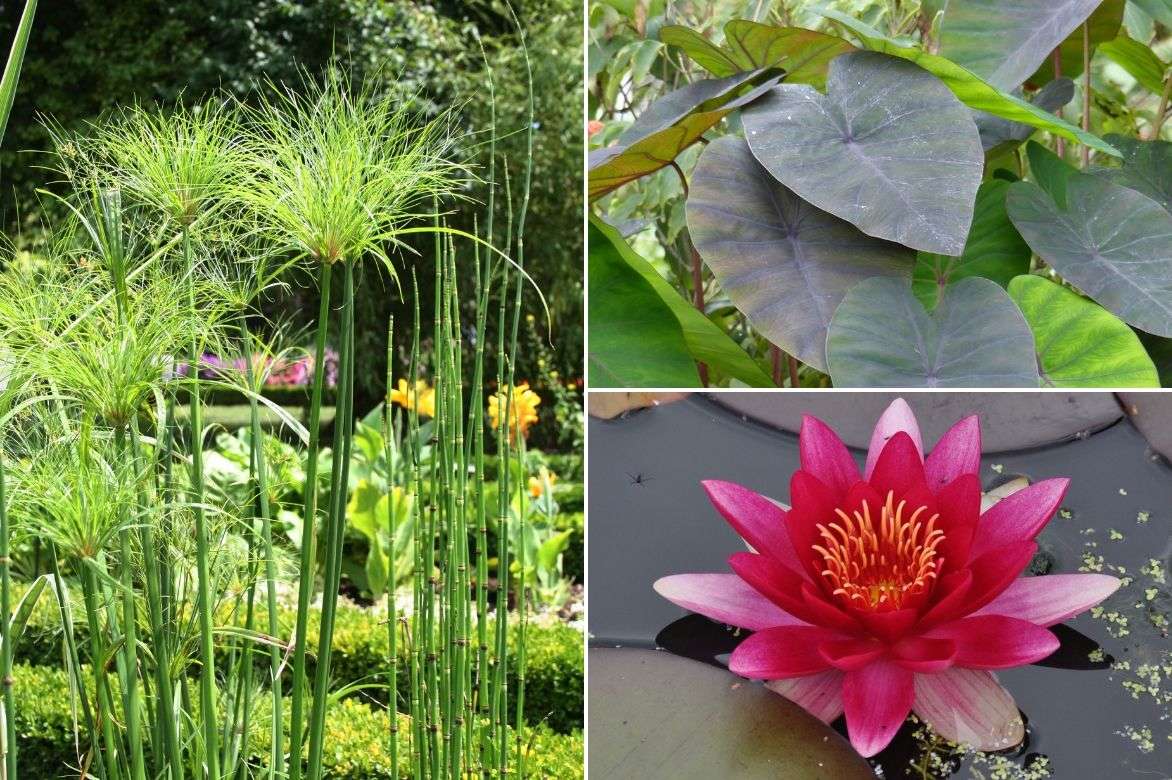
An idea for a combination in a large half-barrel or a small pond: Cyperus papyrus (‘Akhenaton’ or ‘Cleopatra’), Colocasia madeira and Nymphea ‘Attraction’
Eurasian species Cyperus longus or sweet-scented sedge is well suited to ponds and lakes to provide shelter and spawning sites for wild pheasants, moorhens and some visiting ducks. It spreads fairly rapidly by means of its short rootstocks and can occupy an area of 2 to 3 m² in a short time. It is therefore best reserved for large wild-looking gardens to which it will bring a lovely orange glow in autumn. Its very dense growth has the advantage of smothering all weeds.
Small ponds can accommodate Cyperus glaber or alternifolius, if climate allows, for their graphic effect which pairs well with Japanese horsetails but also with marginal perennials such as Virginia ephemerals, Astilbes or primroses, or with stream sedges. These two Cyperus, by virtue of their vertical forms and their stiff stems, are also appreciated in large pots to adorn a terrace or accompany steps of a staircase.
→ Discover more pairing ideas with Cyperus papyrus in our advice sheet !
To learn more
- Discover our range of Papyrus
- Care sheet: Overwintering Cyperus
Frequently asked questions
-
How to overwinter papyrus?
Place the pot in a very sunny, cool or unheated room. If you grow Papyrus indoors, it can help to mist its foliage occasionally, as indoor air is often too dry. In the warmer months, from April–May to October, your potted Papyrus can take pride of place on the terrace or balcony in full sun, but acclimatise it gradually to direct sunlight.
- Subscribe!
- Contents
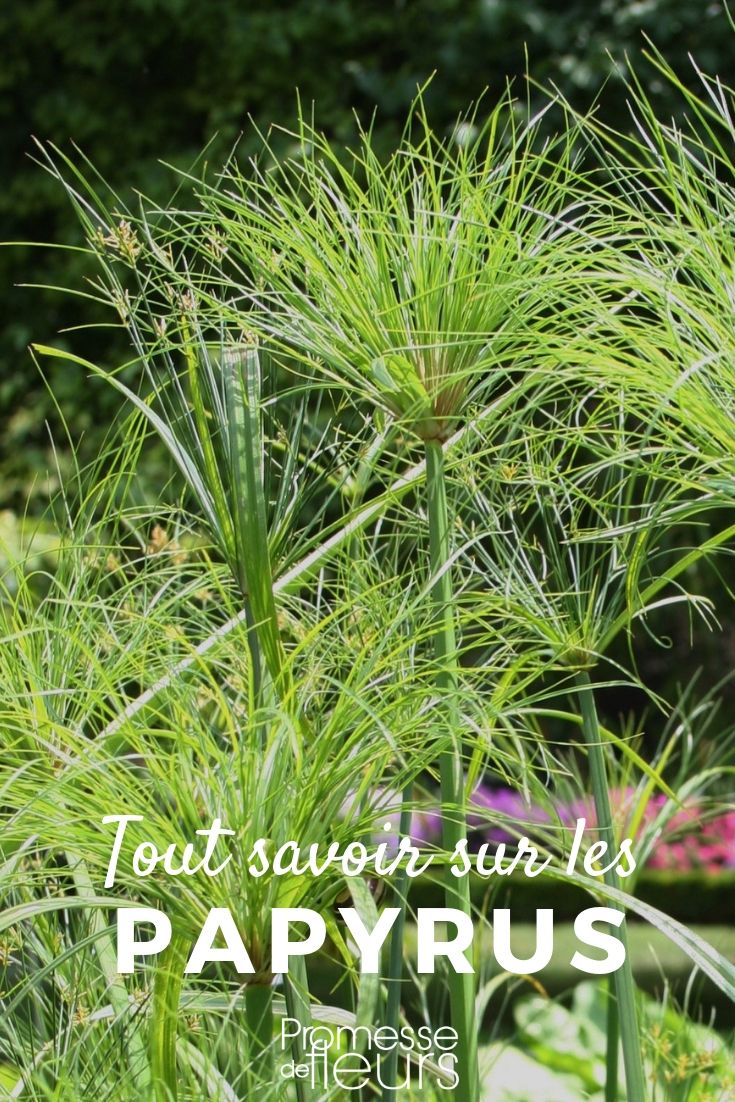
































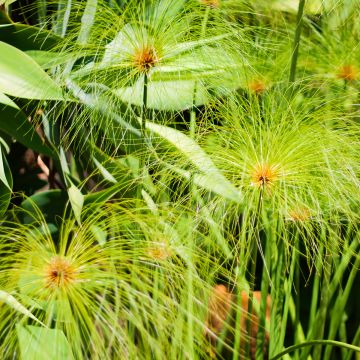


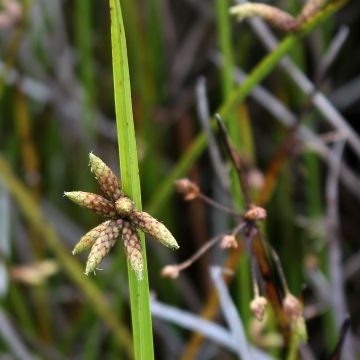
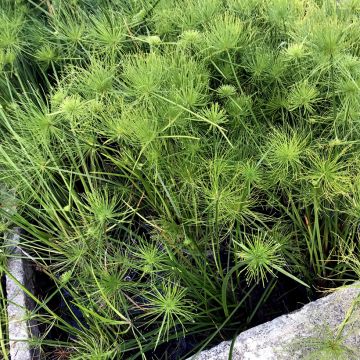
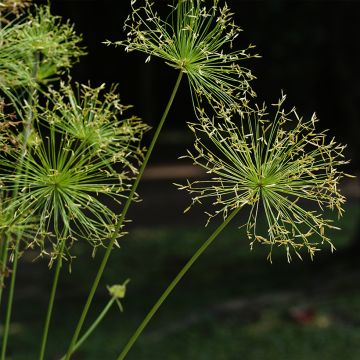
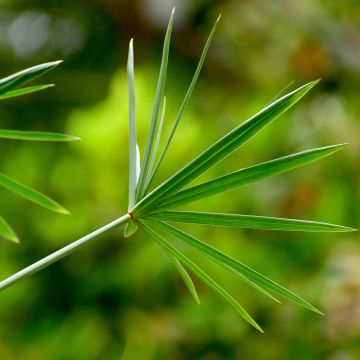

Comments